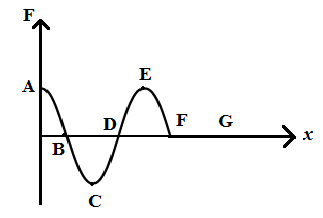
Find the positions of unstable equilibrium.

A. B
B. D
C. F
D. A

Answer
560.1k+ views
Hint: The particle can be said to be in unstable equilibrium if it has positive value of potential energy and it is said to be in stable equilibrium if it has negative value of potential energy. Use the relation between potential and force with respect to distance from the mean position and rearrange it for the potential energy term. In the above figure, the force is given by the cosine function.
Formula used:
\[F = - \dfrac{{dU}}{{dx}}\]
Here, U is the potential energy and x is the distance from the mean position.
Complete step by step answer:
We know that the particle can be said to be in unstable equilibrium if it has positive value of potential energy and it is said to be in stable equilibrium if it has negative value of potential energy.
We have the relation between force and potential energy with respect to the distance from the mean position as follows,
\[F = - \dfrac{{dU}}{{dx}}\]
Here, U is the potential energy and x is the distance from the mean position.
We integrate the above equation as follows,
\[U = - \int F dx\] …… (1)
From the given curve we can observe that the force is given by the cosine function as it does not start from the mean position and path difference is \[\dfrac{\pi }{2}\].
Therefore, we can write, \[F = \cos x\].
We substitute \[F = \cos x\] in the above equation.
\[U = - \int {\cos x} \,dx\]
\[ \Rightarrow U = - \sin x + C\]
Here, C is the constant of integration. We ignore it for the ease in simplification.
From the above equation, the potential energy is positive if \[\sin x\] is negative. When we take a look at the figure, the coordinates of points A, B, C, D, E and F are\[0,\dfrac{\pi }{2},\pi ,\dfrac{{3\pi }}{2},2\pi ,\,{\text{and }}\dfrac{{5\pi }}{2}\].
We know that \[\sin x\] is negative at \[\dfrac{{3\pi }}{2}\]. Therefore, we can say that the particle has positive potential energy at \[x = D = \dfrac{{3\pi }}{2}\]. Thus, the point of unstable equilibrium is D.
So, the correct answer is option (B).
Note:
On the potential energy curve, the points lying on the curve above the mean position towards the positive y-axis are the points of unstable equilibrium and that of below the mean position are the points with stable equilibrium. In the case of unstable equilibrium, the body will not come back to its stable position. One can think of stable equilibrium as a particle on the bottom of a parabolic curve and unstable equilibrium as a particle on top of a hill curve.
Formula used:
\[F = - \dfrac{{dU}}{{dx}}\]
Here, U is the potential energy and x is the distance from the mean position.
Complete step by step answer:
We know that the particle can be said to be in unstable equilibrium if it has positive value of potential energy and it is said to be in stable equilibrium if it has negative value of potential energy.
We have the relation between force and potential energy with respect to the distance from the mean position as follows,
\[F = - \dfrac{{dU}}{{dx}}\]
Here, U is the potential energy and x is the distance from the mean position.
We integrate the above equation as follows,
\[U = - \int F dx\] …… (1)
From the given curve we can observe that the force is given by the cosine function as it does not start from the mean position and path difference is \[\dfrac{\pi }{2}\].
Therefore, we can write, \[F = \cos x\].
We substitute \[F = \cos x\] in the above equation.
\[U = - \int {\cos x} \,dx\]
\[ \Rightarrow U = - \sin x + C\]
Here, C is the constant of integration. We ignore it for the ease in simplification.
From the above equation, the potential energy is positive if \[\sin x\] is negative. When we take a look at the figure, the coordinates of points A, B, C, D, E and F are\[0,\dfrac{\pi }{2},\pi ,\dfrac{{3\pi }}{2},2\pi ,\,{\text{and }}\dfrac{{5\pi }}{2}\].
We know that \[\sin x\] is negative at \[\dfrac{{3\pi }}{2}\]. Therefore, we can say that the particle has positive potential energy at \[x = D = \dfrac{{3\pi }}{2}\]. Thus, the point of unstable equilibrium is D.
So, the correct answer is option (B).
Note:
On the potential energy curve, the points lying on the curve above the mean position towards the positive y-axis are the points of unstable equilibrium and that of below the mean position are the points with stable equilibrium. In the case of unstable equilibrium, the body will not come back to its stable position. One can think of stable equilibrium as a particle on the bottom of a parabolic curve and unstable equilibrium as a particle on top of a hill curve.
Recently Updated Pages
Master Class 12 Business Studies: Engaging Questions & Answers for Success

Master Class 12 Economics: Engaging Questions & Answers for Success

Master Class 12 English: Engaging Questions & Answers for Success

Master Class 12 Maths: Engaging Questions & Answers for Success

Master Class 12 Social Science: Engaging Questions & Answers for Success

Master Class 12 Chemistry: Engaging Questions & Answers for Success

Trending doubts
What is meant by exothermic and endothermic reactions class 11 chemistry CBSE

Which animal has three hearts class 11 biology CBSE

10 examples of friction in our daily life

One Metric ton is equal to kg A 10000 B 1000 C 100 class 11 physics CBSE

1 Quintal is equal to a 110 kg b 10 kg c 100kg d 1000 class 11 physics CBSE

Difference Between Prokaryotic Cells and Eukaryotic Cells




